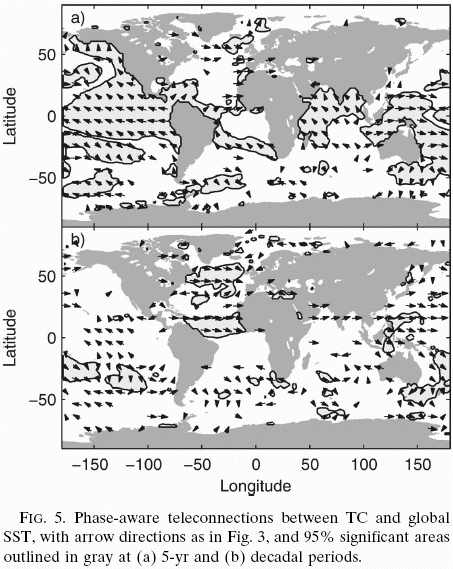Controversy exists over the role of the recent rise in sea surface temperatures (SST) and the frequency of tropical cyclones or hurricanes. Here, 135 yr of observational records are used to demonstrate how sea surface temperature, sea level pressure, and cyclone numbers are linked. A novel wavelet-lag coherence method is used to study cause and effect relations over a large space of time scales, phase lags, and periods. It is found that SST and cyclones are not merely correlated, but are in a negative feedback loop, where rising SST causes increased numbers of cyclones, which reduce SST.
This is statistically most significant at decadal and not at longer periods, which is contrary to expectations if long-period natural cycles are important in driving cyclone numbers. Spatial relationships are examined using phase-aware teleconnections, which at the dominant decadal period show the in-phase behavior of the Atlantic SST in the Gulf Stream region, reflecting the role of the transportion of heat northward from the tropical Atlantic. At 5-yr periods there is significant coherence when SST leads cyclones by 2 yr, and this is associated with tropical ENSO activity such that, as predicted, increasing numbers of El Niños cause fewer Atlantic cyclones. The pattern of coherence existing since 1970 strongly favors the decadal coherence band, and despite growing coherence at higher frequencies, there is none at the 5-yr band, perhaps explaining why the observed sensitivity between SST and cyclones is larger than that from general circulation model (GCM) predictions and becoming greater.
Moore J.C., A. Grinsted, S. Jevrejeva (2008) Gulf Stream and ENSO Increase the Temperature Sensitivity of Atlantic Tropical Cyclones. J. Clim. 21(7): 1523. [pdf]
Interresting new methods presented in the paper:
We have developed some new and very useful statistical techniques which are broadly applicable to many types of causality problems. Mean phase coherence is a good measure of how consistent the phase relationship is between two series. Ofcourse to properly define a phase it is necessary to look at a narrow frequency band and therefore we wavelet filter the series. Phase coherence has many advantages over traditional correlation coefficients. This measure can be expanded onto a spatial grid which we call Phase-aware teleconnections which show the phase relationship and the regions of significant coherence (see figure on the right). Mean phase coherence can also be to examine the causal relationship between two series. In order to do this we vary the wavelet scale and also lag the two series relatively to each other. We call this frequency-lag space expansion of phase coherence ‘wavelet-lag coherence’. This can further be combined with simple linear regression to quantify the relationship. As we show in the paper this can be a powerful tool for uncovering and understanding complex causal relationships.
